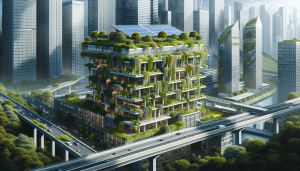In our journey toward a greener future, we’ve begun to understand the profound ways sustainable architecture can enhance our daily lives, specifically in terms of our health. From the way natural sunlight illuminates our rooms to the air we breathe within eco-friendly buildings, each element of sustainable design carries tangible benefits. We explore how these thoughtful choices in construction and materials contribute positively to our well-being, uplifting our mental and physical health. Sustainable architecture isn’t just about the environment—it’s about creating spaces where we can truly thrive. Have you ever wondered how the buildings and spaces where we live, work, and play affect our health? It’s a question that taps into the core of sustainable architecture and its far-reaching impacts on our well-being. As we spend a significant portion of our lives indoors, it’s crucial to consider the profound effects of our built environment. So, let’s dive into how sustainable architecture can directly influence human health!
Understanding Sustainable Architecture
What is Sustainable Architecture?
Sustainable architecture focuses on designing and constructing buildings that minimize environmental impact. These structures aim to utilize resources efficiently, reduce waste, and create healthier living spaces. Essentially, it’s all about harmony with nature while maximizing the well-being of occupants.
Core Principles of Sustainable Architecture
Several principles guide sustainable architecture, promoting both environmental responsibility and human health:
| Principle | Description |
|---|---|
| Energy Efficiency | Buildings are designed to consume less energy by incorporating renewable energy sources, efficient appliances, and high-quality insulation. |
| Water Conservation | Techniques like rainwater harvesting, low-flow fixtures, and wastewater treatment help reduce water usage and preserve resources. |
| Material Selection | Environmentally friendly, non-toxic, and sustainably sourced materials ensure a lesser ecological footprint and healthier indoor air quality. |
| Waste Reduction | Emphasis on reducing, reusing, and recycling construction materials to minimize waste during the building’s lifecycle. |
| Indoor Air Quality | Use of ventilation systems and air-purifying plants to improve the air inhaled by occupants, reducing harmful pollutants and promoting better respiratory health. |
| Site Selection | Choosing locations that minimize environmental disruption and promote biodiversity, ensuring a positive interaction between humans and nature. |
Understanding these principles allows us to see the bigger picture: sustainable design aims to build a better world for everyone by considering environmental impacts and prioritizing well-being.
The Direct Health Impacts of Sustainable Architecture
Enhanced Air Quality
One of the foremost benefits of sustainable architecture is improved air quality. By using non-toxic materials and ensuring adequate ventilation, sustainable buildings help reduce the presence of harmful substances like volatile organic compounds (VOCs). Natural materials, such as bamboo and cork, are often favored because they emit fewer pollutants.
Natural Light and Its Benefits
Maximizing natural light in sustainable buildings is another key aspect. Natural light has been proven to:
- Boost Mood and Productivity: Exposure to daylight helps regulate our circadian rhythms, improving our mood and increasing productivity.
- Improve Sleep Quality: Better natural light exposure during the day can lead to improved sleep at night, enhancing overall health.
- Energy Savings: Utilizing natural light reduces the need for artificial lighting, which can lower energy consumption and promote environmental health.
Thermal Comfort
Thermal comfort significantly influences our physical well-being and productivity. Sustainable architecture takes into account passive design strategies, such as appropriate insulation, high-quality windows, and natural ventilation, to maintain comfortable indoor temperatures. This minimizes the reliance on artificial heating and cooling systems, leading to better energy efficiency and comfort.
Noise Reduction
Noise pollution can be a significant stressor, affecting mental health and concentration. Sustainable architecture often includes soundproofing materials and design features that minimize external noise. This results in quieter indoor environments that reduce stress and improve cognitive function.
Connection to Nature: Biophilic Design
Biophilic design integrates natural elements into buildings, fostering a connection between occupants and nature. This link can greatly enhance mental well-being by reducing stress, boosting creativity, and promoting overall health. Features such as indoor plants, water elements, and natural materials are common in sustainable architecture.

Long-Term Health Benefits
Reducing Chronic Illnesses
Sustainable architecture plays a vital role in mitigating chronic illnesses. For instance, better indoor air quality reduces the likelihood of respiratory conditions such as asthma and allergies. Additionally, buildings designed with physical activity in mind—like those including stairs, walking paths, or communal exercise spaces—encourage healthier lifestyles and lower the risk of obesity, cardiovascular diseases, and diabetes.
Supporting Mental Health
Mental health is another critical area impacted by our built environment. Natural light, green spaces, and reduced noise all contribute to a calming atmosphere that can alleviate anxiety and depression. Biophilic design elements, in particular, have been shown to improve mental health by fostering a sense of tranquility and connection to nature.
Enhancing Social Interaction
Sustainable buildings often incorporate communal areas that promote social interaction. These spaces, such as shared gardens, rooftops, and community rooms, encourage social engagement, which is crucial for mental health and community building. By fostering a sense of belonging and reducing social isolation, these designs can lead to healthier, happier communities.
Economic and Environmental Benefits That Promote Health
Lower Operational Costs
Sustainable buildings often have lower operational costs due to energy and water efficiency. Reduced utility expenses can alleviate financial stress for families and businesses, indirectly promoting mental and economic well-being. These cost savings can then be redirected towards health-promoting activities or further sustainability initiatives.
Environmental Stewardship
A healthier environment directly contributes to public health. By minimizing waste, reducing carbon footprints, and conserving natural resources, sustainable architecture helps protect ecosystems and biodiversity. A robust natural environment ensures the availability of clean air, water, and food, which are all fundamental to human health.
Improved Resilience Against Climate Change
Sustainable buildings are designed to be more resilient to environmental changes. Features like renewable energy systems, water-efficient landscaping, and climate-adaptive construction ensure these buildings can withstand and adapt to climate-related stresses. This resilience reduces the health risks associated with extreme weather events, such as heatwaves, floods, and storms.

Guidelines for Creating Health-Enhancing Sustainable Architecture
Site Assessment and Planning
Selecting an appropriate site is the foundation of sustainable architecture. It entails understanding the local climate, vegetation, topography, and socio-economic context to integrate the building seamlessly with its environment.
Energy-Efficient Building Design
Incorporating passive solar design, proper insulation, energy-efficient windows, and renewable energy sources can significantly reduce a building’s energy consumption. This not only conserves resources but also supports a comfortable indoor climate, enhancing thermal comfort and overall health.
High-Quality Material Selection
Opt for materials that are non-toxic, locally sourced, and have a low environmental impact. Avoid materials with high VOCs or other harmful chemicals that can degrade indoor air quality. Sustainable options include bamboo, reclaimed wood, and recycled metal.
Water Conservation Measures
Incorporate rainwater harvesting, greywater reuse systems, and low-flow fixtures to conserve water. Landscaping with native plants that require minimal watering can further support sustainability and environmental health.
Indoor Environmental Quality
Design buildings to maximize natural light, provide adequate ventilation, and incorporate biophilic elements. These factors are crucial for enhancing air quality, mental well-being, and overall health.
Community-Centric Spaces
Design communal areas that promote social interaction, physical activity, and community engagement. These spaces can include gardens, playgrounds, and multipurpose rooms that foster a sense of community and promote mental health.
Success Stories: Real-Life Examples of Sustainable Architecture
Bullitt Center, Seattle
- Sustainable Features: Known as the greenest commercial building in the world, the Bullitt Center incorporates solar panels, rainwater harvesting, composting toilets, and non-toxic materials.
- Health Benefits: Enhanced indoor air quality, ample natural light, and a stair-centered design promote an active and healthy lifestyle for occupants.
Bosco Verticale, Milan
- Sustainable Features: This residential building complex integrates extensive greenery with over 20,000 plants and trees, improving air quality and providing insulation.
- Health Benefits: The biophilic design reduces stress, noise, and pollution, promoting a healthier living environment for residents.
BedZED, London
- Sustainable Features: Featuring solar panels, energy-efficient appliances, sustainable materials, and a wastewater recycling system, BedZED is an exemplary sustainable housing development.
- Health Benefits: The focus on natural lighting, ventilation, and community spaces enhances both physical and mental well-being for its residents.

Future Trends in Sustainable Architecture and Human Health
Smart and Sustainable Technologies
The integration of smart technologies with sustainable architecture is set to create even healthier buildings. Smart thermostats, air quality monitors, and automated lighting systems will enhance energy efficiency and indoor environmental quality.
Regenerative Design
Going beyond sustainability, regenerative design seeks to restore and enhance ecosystems through building practices. This approach aims to create buildings that not only minimize negative impacts but actively contribute to environmental and human health.
Health-Centric Certification Standards
New standards and certifications, such as the WELL Building Standard, focus explicitly on promoting human health through sustainable design. These standards provide frameworks for designing buildings that support physical, mental, and social well-being.
Conclusion
As we’ve explored, sustainable architecture significantly impacts our health in numerous positive ways. From improving air quality and enhancing natural light to reducing stress through biophilic design, these buildings are crafted with our well-being in mind. Furthermore, the economic and environmental benefits of sustainable architecture indirectly promote health by creating resilient communities and preserving natural resources.
Incorporating these principles into mainstream architecture could pave the way for healthier, happier lives. By understanding and advocating for sustainable design, we all contribute to a better, more sustainable future for ourselves and generations to come. Let’s continue to ask questions, seek better solutions, and build a world where health and sustainability go hand in hand.
Thank you for journeying with us through the incredible impacts of sustainable architecture on human health. Let’s work together to create spaces that nurture our bodies, minds, and the planet we call home!



